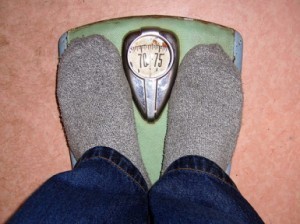How Much Should I Weigh?
Hoe Much Should I Weigh?
Many people try to discover how much they should weigh by the use of height-weight charts. Or they go to a doctor,  dietician or fitness trainer and ask what the right weight is for their height. If they are over the “ideal” they come to the conclusion they’re overweight and need to go on a diet. But the question “How much should I weigh?” isn’t so easily answered. And here’s why.
dietician or fitness trainer and ask what the right weight is for their height. If they are over the “ideal” they come to the conclusion they’re overweight and need to go on a diet. But the question “How much should I weigh?” isn’t so easily answered. And here’s why.
When health experts tell you that being overweight is dangerous to your health, it isn’t the extra pounds that are the problem; it’s the fat that makes them up, if it is fat at all. Too much fat in the body can lead to heart disease. Too much muscle – as in the case of bodybuilders – has not been proven to do the same thing. In other words, weighing more than your ‘ideal” weight in a height weight chart shows is bad only if your body mass is made up of too much fat. That is not the case with Olympic athletes, for example. Even though they register at way past the “ideal” weight, they aren’t fat, and it doesn’t mean their health is at risk. But if you are a couch potato with a pot belly, you may be at risk for cardiovascular problems even if you weigh less than an athlete.
To assess if your weight and build make you a candidate for heart disease, several factors need to be analyzed. These are:
Your body weight in relation to your height
Your and your family’s health background
Your waistline
To find out how much you should weigh, you can start by calculating your body mass index or BMI. The formula for pounds and inches is: weight / (height 2) x 703 = BMI. That is, you take your total height in inches, square it by itself and then divide your weight in pounds by that. You then multiply the result by 703 to get your BMI. To simplify things, you can just refer to a BMI chart.
Here are the BMI standards:
18.5 and below = underweight
Below 25 = normal
25-29.9 = overweight
30 and above = obese
Your family history and your own health habits must be investigated next. Factors that put you at risk for cardiovascular disease include:
age (45+ for men, 55+ or post-menopause for women)
history of cardiovascular disease or diabetes in self
early and severe heart disease among family (below 55 for men, below 65 for women)
smoking
high blood pressure
high blood sugar
high levels of LDL or “bad” cholesterol
low levels of HDL or “good” cholesterol
Finally, measure your waist circumference or waistline. If you have waist measurement like below, you are at risk if you have an existing heart condition or two or more risk factors described above.
Over 40 inches for men
Over 35 inches for women
So remember, it is more than just a height weight chart that can tell you if you are “overweight” or not. Consult with your physician if it appears you are overweight or underweight.





